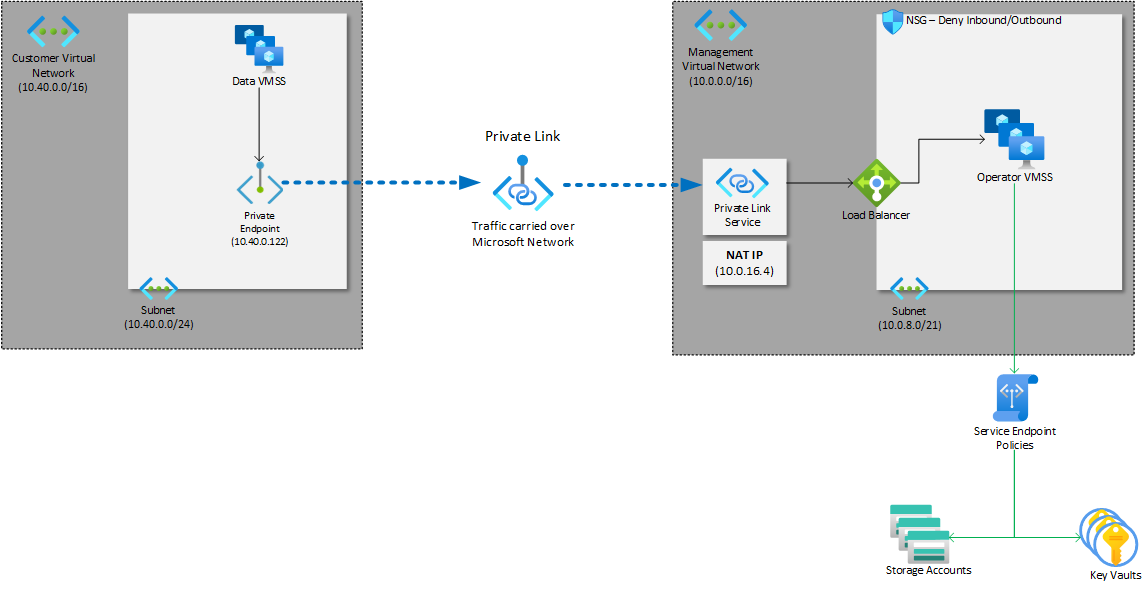Note
Access to this page requires authorization. You can try signing in or changing directories.
Access to this page requires authorization. You can try changing directories.
Azure Managed Instance for Apache Cassandra nodes require access to many other Azure services when they're injected into your virtual network. Normally, access is enabled by ensuring that your virtual network has outbound access to the internet. If your security policy prohibits outbound access, you can configure firewall rules or user-defined routes for the appropriate access. For more information, see Required outbound network rules.
If you have internal security concerns about data exfiltration, your security policy might prohibit direct access to these services from your virtual network. By using a virtual private network (VPN) with Azure Managed Instance for Apache Cassandra, you can ensure that data nodes in the virtual network communicate with only a single VPN endpoint, with no direct access to any other services.
How it works
A virtual machine (VM) called the operator is part of each Azure Managed Instance for Apache Cassandra, and it helps to manage the cluster. By default, the operator is in the same virtual network as the cluster. The operator and data VMs have the same network security group (NSG) rules, which isn't ideal for security reasons. It also lets you prevent the operator from reaching necessary Azure services when you set up NSG rules for your subnet.
Using a VPN as your connection method for Azure Managed Instance for Apache Cassandra lets the operator be in a different virtual network than the cluster by using the private link service. The operator is in a virtual network that has access to the necessary Azure services, and the cluster is in a virtual network that you control.
With the VPN, the operator can now connect to a private IP address inside the address range of your virtual network called a private endpoint. The private link routes the data between the operator and the private endpoint through the Azure backbone network to avoid exposure to the public internet.
Security benefits
We want to prevent attackers from accessing the virtual network where the operator is deployed and attempting to steal data. Security measures are in place to make sure that the operator can reach only necessary Azure services.
- Service endpoint policies: These policies offer granular control over egress traffic within the virtual network, in particular to Azure services. By using service endpoints, they establish restrictions. Policies permit data access exclusively to specified Azure services like Azure Monitor, Azure Storage, and Azure Key Vault. These policies ensure that data egress is limited solely to predetermined Azure Storage accounts, which enhances security and data management within the network infrastructure.
- Network security groups: These groups are used to filter network traffic to and from the resources in an Azure virtual network. All traffic is blocked from the operator to the internet. Only traffic to certain Azure services is allowed through a set of NSG rules.
Use a VPN with Azure Managed Instance for Apache Cassandra
Create an Azure Managed Instance for Apache Cassandra cluster by using
VPNas the value for the--azure-connection-methodoption:az managed-cassandra cluster create \ --cluster-name "vpn-test-cluster" \ --resource-group "vpn-test-rg" \ --location "eastus2" \ --azure-connection-method "VPN" \ --initial-cassandra-admin-password "password"Use the following command to see the cluster properties:
az managed-cassandra cluster show \ --resource-group "vpn-test-rg" \ --cluster-name "vpn-test-cluster"From the output, make a copy of the
privateLinkResourceIdvalue.In the Azure portal, create a private endpoint by following these steps:
- On the Resource tab, select Connect to an Azure resource by resource ID or alias as the connection method and select Microsoft.Network/privateLinkServices as the resource type. Enter the
privateLinkResourceIdvalue from the previous step. - On the Virtual Network tab, select your virtual network's subnet, and select the Statically allocate IP address option.
- Validate and create.
Note
At the moment, the connection between the management service and your private endpoint requires approval from the Azure Managed Instance for Apache Cassandra team.
- On the Resource tab, select Connect to an Azure resource by resource ID or alias as the connection method and select Microsoft.Network/privateLinkServices as the resource type. Enter the
Get the IP address of your private endpoint's network interface.
Create a new datacenter by using the IP address from the previous step as the
--private-endpoint-ip-addressparameter.
Related content
- Learn about hybrid cluster configuration in Azure Managed Instance for Apache Cassandra.
